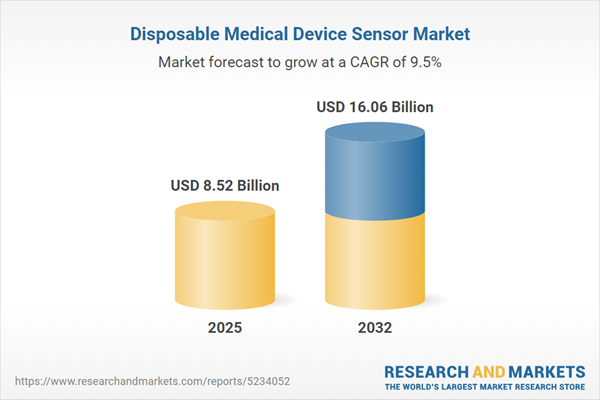Speak directly to the analyst to clarify any post sales queries you may have.
Disposable medical device sensors are redefining clinical practice as healthcare delivery rapidly shifts toward connected, patient-centric environments. Their integration into diagnostics and monitoring workflows unlocks precise insights and supports infection control—all while keeping costs predictable for providers.
Market Snapshot: Disposable Medical Device Sensor Market
The Disposable Medical Device Sensor Market grew from USD 7.78 billion in 2024 to USD 8.52 billion in 2025. It is expected to continue growing at a CAGR of 9.47%, reaching USD 16.06 billion by 2032.
Scope & Segmentation
- Type: Biosensors (glucose and lactate), flow sensors, pH sensors, pressure sensors, temperature sensors
- Technology: Electrochemical (amperometric, conductometric, potentiometric), optical, piezoelectric, thermal
- Application: Diagnostics (glucose monitoring, pH measurement), drug delivery, patient monitoring
- End User: Ambulatory care centers, home healthcare, hospitals and clinics, pharmaceuticals, research laboratories
- Channel: Direct sales, distributors, online retail
- Region: Americas (North America: United States, Canada, Mexico; Latin America: Brazil, Argentina, Chile, Colombia, Peru), Europe, Middle East & Africa (Europe: United Kingdom, Germany, France, Russia, Italy, Spain, Netherlands, Sweden, Poland, Switzerland; Middle East: United Arab Emirates, Saudi Arabia, Qatar, Turkey, Israel; Africa: South Africa, Nigeria, Egypt, Kenya), Asia-Pacific (China, India, Japan, Australia, South Korea, Indonesia, Thailand, Malaysia, Singapore, Taiwan)
- Key Companies: Abbott Laboratories, Medtronic plc, F. Hoffmann-La Roche Ltd., Becton, Dickinson and Company, Thermo Fisher Scientific Inc., Siemens Healthineers AG, Masimo Corporation, Nipro Corporation, ICU Medical, Inc., Nissha Co., Ltd.
Key Takeaways for Disposable Medical Device Sensor Market Stakeholders
- Single-use sensors significantly lower cross-contamination risk and streamline clinical processes by enabling faster decision-making.
- Innovations in materials science and microfabrication drive improvements in sensor sensitivity, selectivity, and versatility for multiple clinical indications.
- Integration of wireless protocols and artificial intelligence is expanding use cases into remote and predictive healthcare, including telehealth and home settings.
- Sustainability is addressed through eco-friendly materials and manufacturing, aligning disposable medical device sensors with environmental objectives.
- Distributed manufacturing and regional partnerships enhance supply chain resilience, making adaptation to demand volatility and policy shifts more feasible.
Tariff Impact and Cost Structure Dynamics
Recent United States tariff policies have increased the cost and complexity of sourcing for disposable medical device sensor manufacturers. These changes have led some companies to realign production strategies, invest in domestic capacity, and seek alternative materials to control expenses. Dynamic procurement, vertical integration, and supplier diversification are increasingly prevalent, enabling greater agility in response to regulatory changes and helping buffer against future trade disruptions. Additionally, innovative sensor designs that require fewer imported parts are gaining traction as firms adapt their portfolios to new policy landscapes.
Methodology & Data Sources
Insights in this report are based on primary interviews with industry leaders and subject matter experts, comprehensive secondary data analysis from leading journals and patent filings, and triangulation with market reports and company disclosures. Data was cross-validated for consistency and segmented by sensor type, technology, end user, and distribution channel to ensure analytical rigor and actionable intelligence.
Why This Report Matters
- Enables decision-makers to benchmark product lines, assess innovation pipelines, and prioritize R&D investments against evolving market trends.
- Provides strategic context to navigate global supply chain risks, regulatory dynamics, and emerging competitive threats in the single-use sensor landscape.
- Informs procurement, sustainability, and commercialization strategies with detailed segmentation and region-specific analysis.
Conclusion
As healthcare systems adopt new delivery models, disposable medical device sensors are critical for unlocking real-time, data-driven insights and supporting sustainable practices. This report offers senior leaders a clear, actionable path to operationalize innovation and build resilient, future-ready organizations in a rapidly evolving sector.
Additional Product Information:
- Purchase of this report includes 1 year online access with quarterly updates.
- This report can be updated on request. Please contact our Customer Experience team using the Ask a Question widget on our website.
Table of Contents
3. Executive Summary
4. Market Overview
7. Cumulative Impact of Artificial Intelligence 2025
Companies Mentioned
The companies profiled in this Disposable Medical Device Sensor market report include:- Abbott Laboratories
- Medtronic plc
- F. Hoffmann-La Roche Ltd.
- Becton, Dickinson and Company
- Thermo Fisher Scientific Inc.
- Siemens Healthineers AG
- Masimo Corporation
- Nipro Corporation
- ICU Medical, Inc.
- Nissha Co., Ltd.
Table Information
| Report Attribute | Details |
|---|---|
| No. of Pages | 183 |
| Published | November 2025 |
| Forecast Period | 2025 - 2032 |
| Estimated Market Value ( USD | $ 8.52 Billion |
| Forecasted Market Value ( USD | $ 16.06 Billion |
| Compound Annual Growth Rate | 9.4% |
| Regions Covered | Global |
| No. of Companies Mentioned | 11 |









